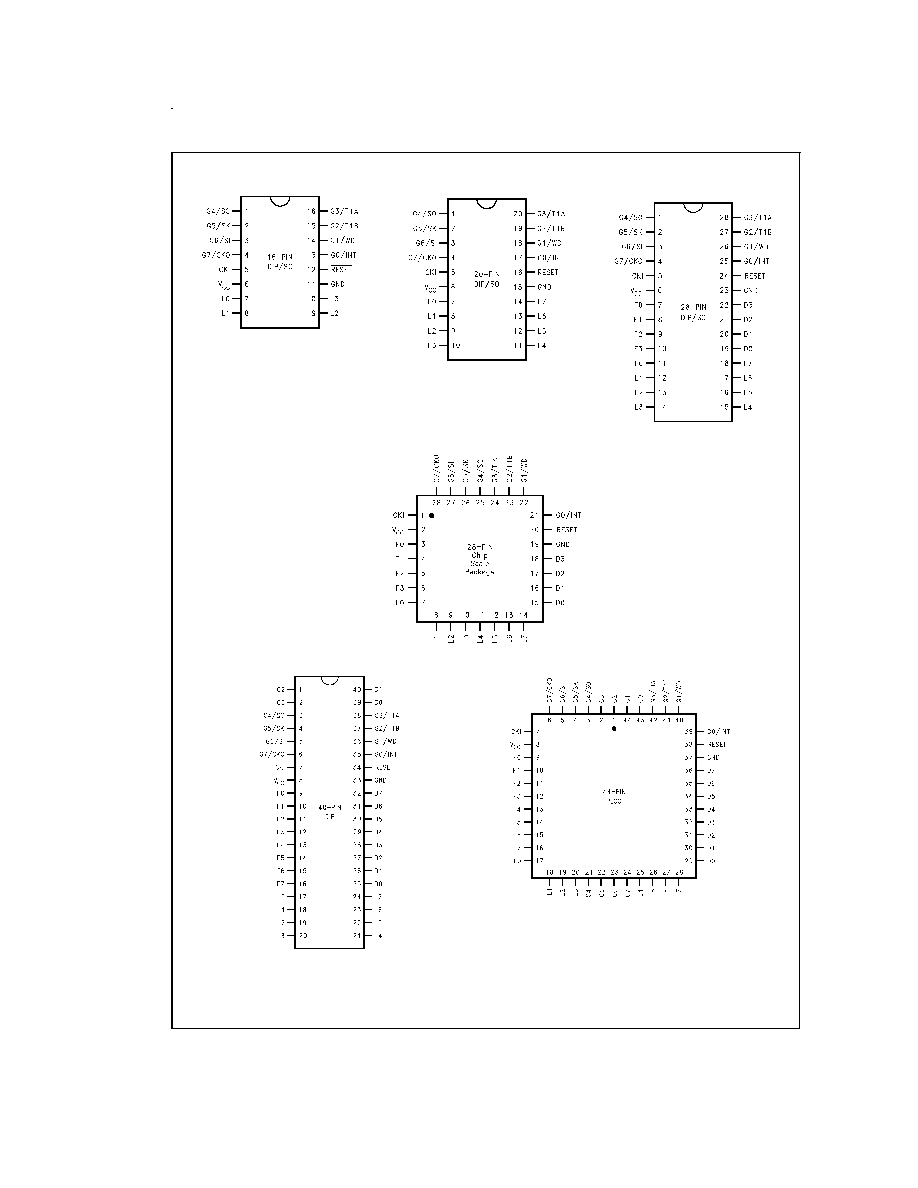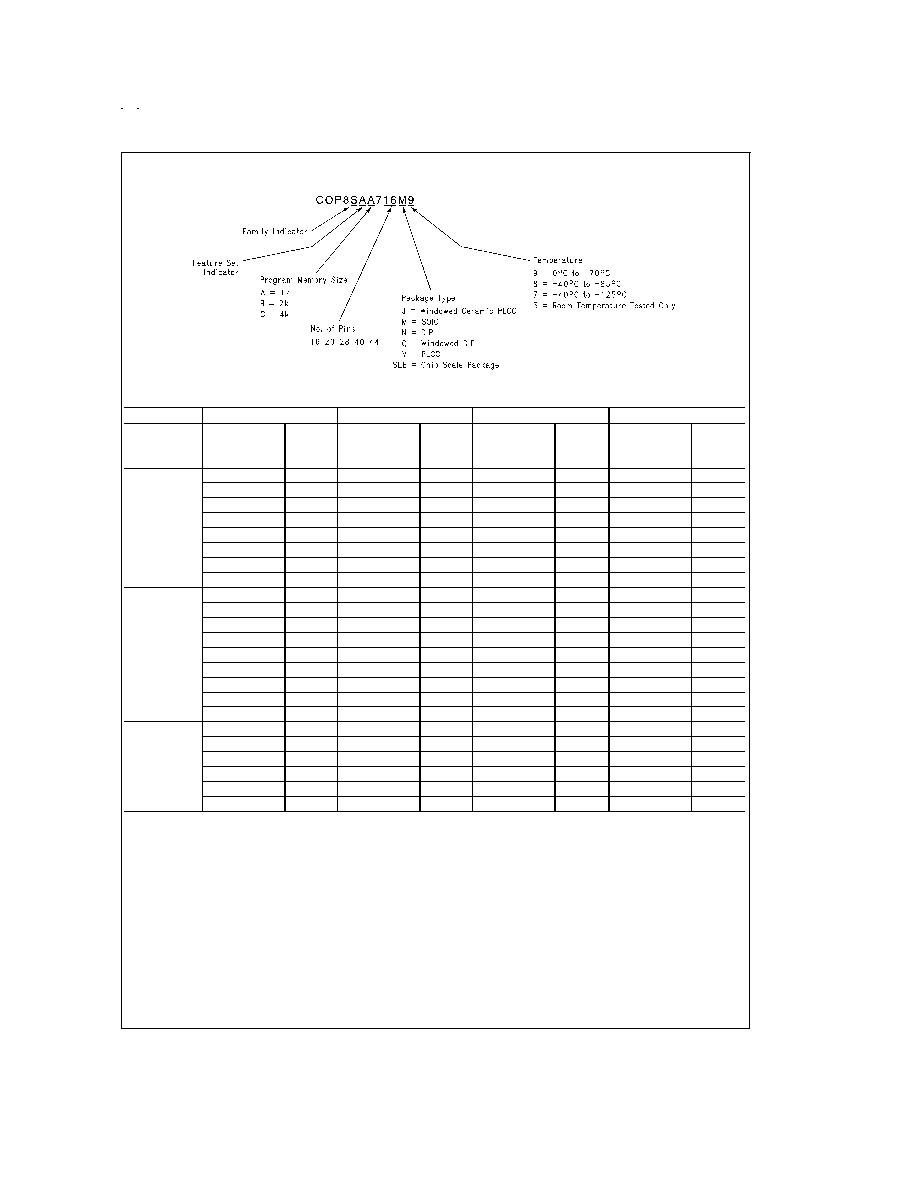
COP8SA Family
8-Bit CMOS ROM Based and One-Time Programmable
(OTP) Microcontroller with 1k to 4k Memory, Power On
Reset, and Very Small Packaging
General Description
Note: COP8SAx devices are instruction set and pin com-
patible supersets of the COP800 Family devices, and are
replacements for these in new designs when possible.
The COPSAx Rom based and OTP microcontrollers are
highly integrated COP8
TM
feature core devices, with 1k to 4k
memory and advanced features including low EMI. These
single-chip CMOS devices are suited for low cost applica-
tions requiring a full featured controller, low EMI, and POR.
100% form-fit-function compatible OTP versions are avail-
able with 1k, 2k, and 4k memory, and in a variety of pack-
ages including 28-pin CSP. Erasable windowed versions are
available for use with a range of COP8 software and hard-
ware development tools.
Family features include an 8-bit memory mapped architec-
ture, 10 MHz CKI with 1 µs instruction cycle, one multi-
function
16-bit
timer/counter
with
PWM
output,
MICROWIRE/PLUS
TM
serial I/O, two power saving HALT/
IDLE modes, MIWU, idle timer, on-chip R/C oscillator, 12
high current outputs, user selectable options (WATCH-
DOG
TM
, 4 clock/oscillator modes, power-on-reset), low EMI
2.7V to 5.5V operation, and 16/20/28/40/44 pin packages.
Devices included in this datasheet are:
Device
Memory
(bytes)
RAM
(bytes)
I/O Pins
Packages
Temperature
COP8SAA5
1k ROM
64
12/16/24
16/20/28 DIP/SOIC
0 to +70∞C, -40 to +85∞C,
-40 to +125∞C
COP8SAB5
2k ROM
128
16/24
20/28 DIP/SOIC
0 to +70∞C, -40 to +85∞C,
-40 to +125∞C
COP8SAC5
4k ROM
128
16/24/36/40
20/28 DIP/SOIC, 28 CSP,
40 DIP, 44 PLCC/QFP
0 to +70∞C, -40 to +85∞C,
-40 to +125∞C
COP8SAA7
1k OTP EPROM
64
12/16/24
16/20/28 DIP/SOIC
0 to +70∞C, -40 to +85∞C,
-40 to +125∞C
COP8SAB7
2k OTP EPROM
128
16/24
20/28 DIP/SOIC
0 to +70∞C, -40 to +85∞C,
-40 to +125∞C
COP8SAC7
4k OTP EPROM
128
16/24
20/28 DIP/SOIC, 28 CSP,
40 DIP, 44 PLCC/QFP
0 to +70∞C, -40 to +85∞C,
-40 to +125∞C
COP8SAA7SLB9
1k OTP EPROM
64
24
28 CSP
0 to +70∞C
COP8SAB7SLB9
2k OTP EPROM
128
24
28 CSP
0 to +70∞C
COP8SAC7SLB9
4k OTP EPROM
128
24
28 CSP
0 to +70∞C
COP8SAC7-Q3
4k EPROM
128
16/24/36
20/28/40 DIP
Room Temp. Only
COP8SAC7-J3
4k EPROM
128
40
44 PLCC
Room Temp. Only
Key Features
n
Low cost 8-bit OTP microcontroller
n
OTP program space with read/write protection (fully
secured)
n
Quiet Design (low radiated emissions)
n
Multi-Input Wakeup pins with optional interrupts
(4 to 8 pins)
n
8 bytes of user storage space in EPROM
n
User selectable clock options
-- Crystal/Resonator options
-- Crystal/Resonator option with on-chip bias resistor
-- External oscillator
-- Internal R/C oscillator
n
Internal Power-On Reset -- user selectable
n
WATCHDOG and Clock Monitor Logic -- user selectable
n
Up to 12 high current outputs
TRI-STATE
Æ
is a registered trademark of National Semiconductor Corporation.
MICROWIRE/PLUS
TM
, COP8
TM
, MICROWIRE
TM
and WATCHDOG
TM
are trademarks of National Semiconductor Corporation.
iceMASTER
Æ
is a registered trademark of MetaLink Corporation.
PRELIMINARY
July 1999
COP8SA
Family,
8-Bit
CMOS
ROM
Based
and
One-T
ime
Programmable
(OTP)
Microcontroller
with
1k
to
4k
Memory,
Power
On
Reset,
and
V
ery
Small
Packaging
© 1999 National Semiconductor Corporation
DS012838
www.national.com

CPU Features
n
Versatile easy to use instruction set
n
1 µs instruction cycle time
n
Eight multi-source vectored interrupts servicing
-- External interrupt
-- Idle Timer T0
-- One Timer (with 2 interrupts)
-- MICROWIRE/PLUS Serial Interface
-- Multi-Input Wake Up
-- Software Trap
-- Default VIS (default interrupt)
n
8-bit Stack Pointer SP (stack in RAM)
n
Two 8-bit Register Indirect Data Memory Pointers
n
True bit manipulation
n
Memory mapped I/O
n
BCD arithmetic instructions
Peripheral Features
n
Multi-Input Wakeup Logic
n
One 16-bit timer with two 16-bit registers supporting:
-- Processor Independent PWM mode
-- External Event counter mode
-- Input Capture mode
n
Idle Timer
n
MICROWIRE/PLUS Serial Interface (SPI Compatible)
I/O Features
n
Software selectable I/O options
-- TRI-STATE
Æ
Output
-- Push-Pull Output
-- Weak Pull Up Input
-- High Impedance Input
n
Schmitt trigger inputs on ports G and L
n
Up to 12 high current outputs
n
Pin efficient (i.e., 40 pins in 44-pin package are devoted
to useful I/O)
Fully Static CMOS Design
n
Low current drain (typically
<
4 µA)
n
Single supply operation: 2.7V to 5.5V
n
Two power saving modes: HALT and IDLE
Temperature Ranges
0∞C to +70∞C, -40∞C to +85∞C, and -40∞C to +125∞C
Development Support
n
Windowed packages for DIP and PLCC
n
Real time emulation and full program debug offered by
MetaLink Development System
Block Diagram
DS012838-1
FIGURE 1. COP8SAx Block Diagram
www.national.com
2

General Description
(Continued)
Key features include an 8-bit memory mapped architecture,
a 16-bit timer/counter with two associated 16-bit registers
supporting three modes (Processor Independent PWM gen-
eration, External Event counter, and Input Capture capabili-
ties),
two
power
saving
HALT/IDLE
modes
with
a
multi-sourced wakeup/interrupt capability, on-chip R/C oscil-
lator, high current outputs, user selectable options such as
WATCHDOG, Oscillator configuration, and power-on-reset.
1.1 EMI REDUCTION
The COP8SAx family of devices incorporates circuitry that
guards against electromagnetic interference -- an increasing
problem in today's microcontroller board designs. National's
patented EMI reduction technology offers low EMI clock cir-
cuitry, gradual turn-on output drivers (GTOs) and internal I
CC
smoothing filters, to help circumvent many of the EMI issues
influencing
embedded
control
designs.
National
has
achieved 15 dB≠20 dB reduction in EMI transmissions when
designs have incorporated its patented EMI reducing cir-
cuitry.
1.2 ARCHITECTURE
The COP8SAx family is based on a modified Harvard archi-
tecture, which allows data tables to be accessed directly
from program memory. This is very important with modern
microcontroller-based applications, since program memory
is usually ROM or EPROM, while data memory is usually
RAM. Consequently data tables usually need to be con-
tained in ROM or EPROM, so they are not lost when the mi-
crocontroller is powered down. In a modified Harvard archi-
tecture, instruction fetch and memory data transfers can be
overlapped with a two stage pipeline, which allows the next
instruction to be fetched from program memory while the
current instruction is being executed using data memory.
This is not possible with a Von Neumann single-address bus
architecture.
The COP8SAx family supports a software stack scheme that
allows the user to incorporate many subroutine calls. This
capability is important when using High Level Languages.
With a hardware stack, the user is limited to a small fixed
number of stack levels.
1.3 INSTRUCTION SET
In today's 8-bit microcontroller application arena cost/
performance, flexibility and time to market are several of the
key issues that system designers face in attempting to build
well-engineered products that compete in the marketplace.
Many of these issues can be addressed through the manner
in which a microcontroller's instruction set handles process-
ing tasks. And that's why COP8 family offers a unique and
code-efficient instruction set -- one that provides the flexibil-
ity, functionality, reduced costs and faster time to market that
today's microcontroller based products require.
Code efficiency is important because it enables designers to
pack more on-chip functionality into less program memory
space (ROM/OTP). Selecting a microcontroller with less pro-
gram memory size translates into lower system costs, and
the added security of knowing that more code can be packed
into the available program memory space.
1.3.1 Key Instruction Set Features
The COP8SAx family incorporates a unique combination of
instruction set features, which provide designers with opti-
mum code efficiency and program memory utilization.
Single Byte/Single Cycle Code Execution
The efficiency is due to the fact that the majority of instruc-
tions are of the single byte variety, resulting in minimum pro-
gram space. Because compact code does not occupy a sub-
stantial amount of program memory space, designers can
integrate additional features and functionality into the micro-
controller program memory space. Also, the majority instruc-
tions executed by the device are single cycle, resulting in
minimum program execution time. In fact, 77% of the instruc-
tions are single byte single cycle, providing greater code and
I/O efficiency, and faster code execution.
1.3.2 Many Single-Byte, Multifunction Instructions
The COP8SAx instruction set utilizes many single-byte, mul-
tifunction instructions. This enables a single instruction to ac-
complish multiple functions, such as DRSZ, DCOR, JID, and
LOAD/EXCHANGE instructions with post-incrementing and
post-decrementing, to name just a few examples. In many
cases, the instruction set can simultaneously execute as
many as three functions with the same single-byte instruc-
tion.
JID: (Jump Indirect); Single byte instruction; decodes exter-
nal events and jumps to corresponding service routines
(analogous to "DO CASE" statements in higher level lan-
guages).
LAID: (Load Accumulator-Indirect); Single byte look up table
instruction provides efficient data path from the program
memory to the CPU. This instruction can be used for table
lookup and to read the entire program memory for checksum
calculations.
RETSK: (Return Skip); Single byte instruction allows return
from subroutine and skips next instruction. Decision to
branch can be made in the subroutine itself, saving code.
AUTOINC/DEC: (Auto-Increment/Auto-Decrement); These
instructions use the two memory pointers B and X to effi-
ciently process a block of data (analogous to "FOR NEXT" in
higher level languages).
1.3.3 Bit-Level Control
Bit-level control over many of the microcontroller's I/O ports
provides a flexible means to ease layout concerns and save
board space. All members of the COP8 family provide the
ability to set, reset and test any individual bit in the data
memory address space, including memory-mapped I/O ports
and associated registers. Three memory-mapped pointers
handle register indirect addressing and software stack
pointer functions. The memory data pointers allow the option
of post-incrementing or post-decrementing with the data
movement
instructions
(LOAD/EXCHANGE).
And
15
memory-maped registers allow designers to optimize the
precise implementation of certain specific instructions.
1.4 PACKAGING/PIN EFFICIENCY
Real estate and board configuration considerations demand
maximum space and pin efficiency, particularly given today's
high integration and small product form factors. Microcontrol-
ler users try to avoid using large packages to get the I/O
needed. Large packages take valuable board space and in-
creases device cost, two trade-offs that microcontroller de-
signs can ill afford.
The COP8 family offers a wide range of packages and do not
waste pins: up to 90.9% (or 40 pins in the 44-pin package)
are devoted to useful I/O.
www.national.com
3

Connection Diagrams
DS012838-2
Top View
DS012838-3
Top View
DS012838-4
Top View
DS012838-39
Top View
DS012838-5
Top View
DS012838-6
Top View
FIGURE 2. Connection Diagrams
www.national.com
4

Ordering Information
1k EPROM
2k EPROM
4k EPROM
4k EPROM
Windowed
Device
Temperature
Order Number
Package
Order Number
Package
Order Number
Package
Order Number
Package
0∞C to +70∞C
COP8SAA716M9
16M
COP8SAA720M9
20M
COP8SAB720M9
20M
COP8SAC720M9
20M
COP8SAA728M9
28M
COP8SAB728M9
28M
COP8SAC728M9
28M
COP8SAA716N9
16N
COP8SAA720N9
20N
COP8SAB720N9
20N
COP8SAC720N9
20N
COP8SAC720Q3
20Q
COP8SAA728N9
28N
COP8SAB728N9
28N
COP8SAC728N9
28N
COP8SAC728Q3
28Q
COP8SAC740N9
40N
COP8SAC740Q3
40Q
COP8SAC744V9
44V
COP8SAC744J3
44J
-40∞C to +85∞C
COP8SAA716M8
16M
COP8SAA720M8
20M
COP8SAB720M8
20M
COP8SAC720M8
20M
COP8SAA728M8
28M
COP8SAB728M8
28M
COP8SAC728M8
28M
COP8SAA716N8
16N
COP8SAA720N8
20N
COP8SAB720N8
20N
COP8SAC720N8
20N
COP8SAA728N8
28N
COP8SAB728N8
28N
COP8SAC728N8
28N
COP8SAC740N8
40N
COP8SAC744V8
44V
COP8SAA7SLB8
SLB
COP8SAB7SLB8
SLB
COP8SAC7SLB8
SLB
-40∞C to
+125∞C
COP8SAC720M7
20M
COP8SAC728M7
28M
COP8SAC720N7
20N
COP8SAC728N7
28N
COP8SAC740N7
40N
COP8SAC744V7
44V
DS012838-8
FIGURE 3. Part Numbering Scheme
www.national.com
5




